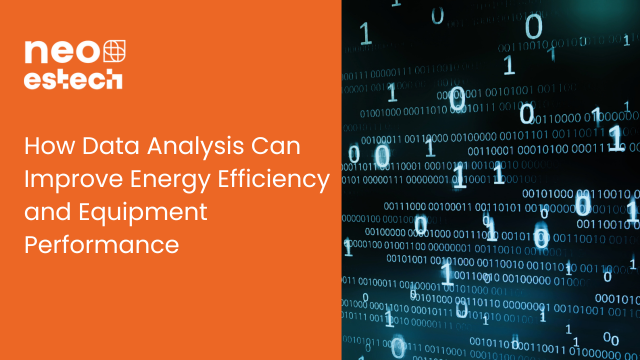In today's business landscape, the importance of data in energy management and equipment performance is crucial for companies like NEO Estech, which seek to optimize energy use and maximize equipment efficiency. Data collection and analysis enable the identification of opportunities for savings, prediction of failures, and ensuring that systems operate under ideal conditions.
Importance of Data in Energy Management and Equipment Performance: Effective energy and equipment management depends on a detailed understanding of how energy is consumed and how equipment operates. Data provides this visibility, allowing companies to identify areas of waste and implement optimization strategies.
Data Collection and Continuous Monitoring: Data collection is the first step in improving energy efficiency and equipment performance. This involves using sensors, smart meters, and IoT devices to capture detailed information about energy consumption and equipment operation. Continuous monitoring enables companies to maintain an accurate record of energy use and equipment condition, identifying anomalies or peaks in consumption and potential failures.
Data Analysis Tools for Energy Efficiency and Equipment Performance:
- Energy and Equipment Dashboards: Visual interfaces that display energy consumption and equipment performance data in real-time, facilitating the identification of high-consumption areas and potential issues.
- Analysis Software: Programs that process historical and real-time data to provide detailed insights into energy consumption and equipment performance.
- Predictive Models: Algorithms that use historical data to predict future energy consumption and equipment behavior, aiding in proactive decision-making.
- Customized Reports: Tools that generate customized reports with specific recommendations for improving energy efficiency and equipment performance.
Examples of Data-Driven Optimization of Energy and Equipment:
- Refrigeration Systems: Use temperature and pressure sensor data to automatically adjust compressor operation, ensuring maximum efficiency and preventing failures.
- HVAC Systems: Analyze temperature, humidity, and CO2 sensor data to optimize ventilation and air conditioning, reducing energy consumption and improving comfort.
- Equipment Monitoring: Use vibration and temperature data to predict failures and schedule preventive maintenance, preventing unexpected downtime and prolonging equipment lifespan.
Benefits of a Data-Driven Approach:
- • Cost Reduction: Identifying and eliminating energy waste and equipment issues can result in significant operational cost savings.
- • Sustainability: Improving energy efficiency contributes to reducing the company's carbon footprint, promoting more sustainable practices.
- Reliability: Continuous monitoring enables early detection of problems, reducing the risk of unexpected failures and operational interruptions.
- Informed Decision-Making: Accurate and detailed data provides the basis for strategic decisions on energy efficiency investments and equipment maintenance.
- Predictability and Anticipation: Data analysis makes it possible to predict consumption patterns and equipment behavior, allowing proactive actions to avoid problems and optimize operations.
Conclusion: Data analysis is a powerful tool for improving energy efficiency and equipment performance. Continuous collection and monitoring, combined with advanced analytics tools, enable companies to identify savings opportunities, optimize resource usage and reduce operational costs. Adopting a data-driven approach is essential for any organization that wants to be more efficient and sustainable.
Recommendations for Starting to Use Data Analysis:
- Invest in Data Collection Technologies: Implement sensors, smart meters, and IoT devices.
- Utilize Analysis Software: Adopt energy and equipment management platforms that offer dashboards, customized reports, and predictive models.
- Train the Team: Educate employees to interpret data and implement recommendations for improvement.
- Stay Up-to-Date: Continuously explore new technologies and analysis methods to improve energy efficiency and equipment performance.
By following these recommendations, companies can maximize the potential of data to achieve efficient energy management and maximize equipment performance.


